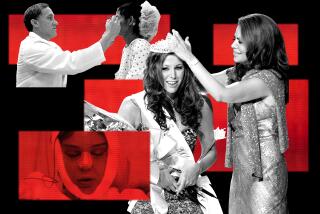‘Black Swan’s’ psychological spin
- Share via
The premise
Nina Sayers (Natalie Portman) dances for a New York City ballet company that is preparing for a production of “Swan Lake.” Stressed out by the competition to be the Swan Queen and smothered by a controlling mother (Barbara Hershey), Nina starts scratching and pulling off chunks of her own skin. She suffers from growing paranoia and startling delusions, including violent and erotic hallucinations involving her competitor Lily (Mila Kunis). On stage, Nina gives stirring performances as both the white swan and the evil seductress black swan. But as pressure mounts, her hallucinations worsen. She sees barbs sprouting from her skin and appears to hallucinate that she has real wings. Her visions fuel an imagined dramatic confrontation that ends the film on a bloody — and perhaps deadly — note.
The medical questions
Are self-mutilation, paranoid delusions and visual hallucinations part of a known psychotic disorder or other mental problem? Can the combination of excess stress, perfectionism and a controlling parent really push a person so far over the edge?
The Reality: “This may not be psychosis at all,” says Dr. Dolores Malaspina, professor of psychiatry and director of Social and Psychiatric Initiatives at New York University Langone Medical Center. According to Malaspina, Nina’s affliction is most consistent with a severely neurotic, obsessive-compulsive patient with features of a borderline personality disorder who suffers from “mini-psychotic episodes.”
The frank visual hallucinations portrayed in the movie are quite rare and not realistic, Malaspina says. The audience, she says, should think of the harrowing visions as fantasies rather than actual hallucinations.
Malaspina does appreciate the movie’s psychological symbolism. The two swans, she says, nicely represent Nina’s internal conflicts. “The next stage in her psychological growth will be the emotional fusion of her white swan and black swan,” she says.
Rachel Loewy, assistant adjunct professor of psychiatry at UC San Francisco, agrees that Nina’s troubles could be consistent with a borderline personality disorder (in which a person has difficulty setting proper boundaries between herself and others) rather than a full-blown psychosis. However, Loewy believes that Nina’s hallucinations and fantasies could also suggest that she has lost track of reality altogether. If she is convinced that she is turning into a bird, then she probably has a psychotic disorder with a side of bizarre delusions, a decidedly serious situation.
Stress can trigger a psychotic episode in people who are already vulnerable, Loewy says. Stress in the family environment is a common trigger, although parenting style is not generally a cause of psychosis, she adds, so we can’t blame everything on Nina’s mother.
Malaspina thinks Nina’s prognosis is good with psychotherapy, small doses of antipsychotics and perhaps antidepressants. The key is a strong therapeutic alliance with the therapist. She suspects that the bloody scene at the end may be a fantasy, which would certainly reduce the need for emergency surgery, CPR or blood transfusions.
Loewy believes that Nina may be psychotic enough to actually commit the act at the end of the film but that she still has a chance for psychological recovery if treated. Since the common side effects of antipsychotic drugs include weight gain and lethargy — two complications that are not exactly compatible with ballet dancing — if Nina truly is psychotic, she may have to give up her career in order to regain her mind.
Siegel is an associate professor of medicine and medical director of Doctor Radio at NYU Langone Medical Center.
“Black Swan”
Fox Searchlight Pictures
U.S. release: Dec. 3, 2010
More to Read
The biggest entertainment stories
Get our big stories about Hollywood, film, television, music, arts, culture and more right in your inbox as soon as they publish.
You may occasionally receive promotional content from the Los Angeles Times.










